It looks like you're using an Ad Blocker.
Please white-list or disable AboveTopSecret.com in your ad-blocking tool.
Thank you.
Some features of ATS will be disabled while you continue to use an ad-blocker.
share:
OK, I have done this the correct way by asking a question and not pretending that I know it all.
Anyone who feels uncomfortable with this suggestion that it may show a simple leaf from a moss-like or ancient plant species can suggest what this images shows please?
The image below shows what I feel MAY be an example of a simple plant section. Actually, it shows 2 such examples and may be different species. I am not a biologist but the purple arrow looks like it might be pointing to a 'knuckle' joint where, on Earth, cacti etc often break off and start to grow another small plant.
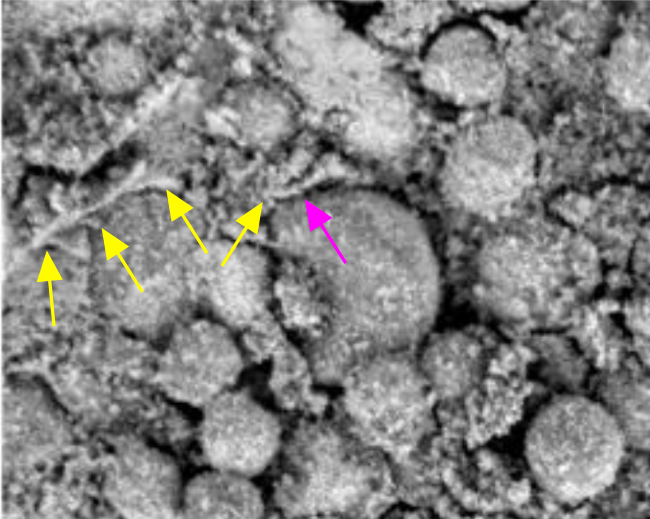
All around this area and in other MI images there seems to be more of this simple plant-like examples.
Official image from NASA (See top left of image)
Sol 420 Site 52
Opportunity
This taken with my possible fungus stalk blueberry thread and my lichen thread I feel really suggest the possibility of plant life on Mars.
What do you think?
Please try to keep this thread about the topic rather than attacking me for bringing it here. If there were no threads, then there would be no ATS.
Anyone who feels uncomfortable with this suggestion that it may show a simple leaf from a moss-like or ancient plant species can suggest what this images shows please?
The image below shows what I feel MAY be an example of a simple plant section. Actually, it shows 2 such examples and may be different species. I am not a biologist but the purple arrow looks like it might be pointing to a 'knuckle' joint where, on Earth, cacti etc often break off and start to grow another small plant.

All around this area and in other MI images there seems to be more of this simple plant-like examples.
Official image from NASA (See top left of image)
Sol 420 Site 52
Opportunity
This taken with my possible fungus stalk blueberry thread and my lichen thread I feel really suggest the possibility of plant life on Mars.
What do you think?
Please try to keep this thread about the topic rather than attacking me for bringing it here. If there were no threads, then there would be no ATS.
Minerals can grow that way, remember that all plants are combinations of minerals. their structure being steered by their DNA. I grew crystals in
branchlike formation like that back in the late sixties in a week long science summer school at the local college. I was probably about fourteen.
The presence of a liquid would probably be necessary for that. Look at frost formations on windows, think about if they were made of something that
solidified instead of evaporated.
reply to post by qmantoo
I can see where you'd get the idea it was a plant, but I don't think it is one. I think it's just a case of pareidolia.
I seriously doubt any plant life would be able to survive on the surface of Mars, much less a lone plant out in the middle of a desert full of rocks. I think it's just a formation in the soil or rocks that makes it look like a plant stalk.
I can see where you'd get the idea it was a plant, but I don't think it is one. I think it's just a case of pareidolia.
I seriously doubt any plant life would be able to survive on the surface of Mars, much less a lone plant out in the middle of a desert full of rocks. I think it's just a formation in the soil or rocks that makes it look like a plant stalk.
That's the one thing I do hate about the black and white or grey scaled images: color would do us a world of good here.
I see the shape you are talking about, and looking at the original photo in your link, I can spot a couple of more (thought there were 3 but that one looks more like the material).
If it's a "plant" say a root system? or a stem? It's very small of course (that doesn't debunk it at all, just noting the size).
The reason having true color would help is that the color of it might be different from the rest of the material in the image. Like plants here on Earth, different areas of a plant have different colors and serve a function in some ways, like the green in leaves and stalks for photosythisis.
Roots tend to be light in color, while many supporting structures can have darker colors (branches).
We know flowering plants on Earth tend to have bright colors in order to attract insects that help with pollination.
One would assume (sorry, have to assume since we don't actually have a example of a extraterrestrial plant to go by) that a Mars plant would have colors different from the rocks and soil. So again, a color picture would have been a huge help here.
Is it a plant or not? No way to really tell with just this photo of course. One could cite the conditions on Mars are not suitable for plants, but that is using Earth plants as an example.
Might it be something fossilized? I won't say that it can't be with 100% certainty as again, all we have is a photo.
Good catch. It certainly is very interesting looking.
I see the shape you are talking about, and looking at the original photo in your link, I can spot a couple of more (thought there were 3 but that one looks more like the material).
If it's a "plant" say a root system? or a stem? It's very small of course (that doesn't debunk it at all, just noting the size).
The reason having true color would help is that the color of it might be different from the rest of the material in the image. Like plants here on Earth, different areas of a plant have different colors and serve a function in some ways, like the green in leaves and stalks for photosythisis.
Roots tend to be light in color, while many supporting structures can have darker colors (branches).
We know flowering plants on Earth tend to have bright colors in order to attract insects that help with pollination.
One would assume (sorry, have to assume since we don't actually have a example of a extraterrestrial plant to go by) that a Mars plant would have colors different from the rocks and soil. So again, a color picture would have been a huge help here.
Is it a plant or not? No way to really tell with just this photo of course. One could cite the conditions on Mars are not suitable for plants, but that is using Earth plants as an example.
Might it be something fossilized? I won't say that it can't be with 100% certainty as again, all we have is a photo.
Good catch. It certainly is very interesting looking.
If you do not want anyone even thinking about the possibility of life on Mars, what do you do? You lay the groundwork first by telling everyone that
the environment is so harsh that life would be impossible.
However, there are species which can survive in space which is super cold and in the bottom of the ocean near volcano fumeroles, so are we saying here that life is definitely impossible in this environment? No, we should not close our minds to the possibility but to look for signs, not just one or two but many different and diverse ways that life might exist.
The temperature rises to over 30 degrees C in some places no Mars I believe and admittedly goes down very low too. There is water vapour in the early morning and overnight in the sheltered areas like canyons etc.
Recurring methane has been found which may signal a presence of life.
However, there are species which can survive in space which is super cold and in the bottom of the ocean near volcano fumeroles, so are we saying here that life is definitely impossible in this environment? No, we should not close our minds to the possibility but to look for signs, not just one or two but many different and diverse ways that life might exist.
The temperature rises to over 30 degrees C in some places no Mars I believe and admittedly goes down very low too. There is water vapour in the early morning and overnight in the sheltered areas like canyons etc.
Recurring methane has been found which may signal a presence of life.
reply to post by qmantoo
qmantoo, 1 is not sure of these mineral like structures in the OP but would advise you as you scan the images that you keep in mind that MARS and EA*RTH provide different growing potentials for FLORA and if there is some growing up there or was it may not resemble the EA*RTH based FLORA...
NAMASTE*******
qmantoo, 1 is not sure of these mineral like structures in the OP but would advise you as you scan the images that you keep in mind that MARS and EA*RTH provide different growing potentials for FLORA and if there is some growing up there or was it may not resemble the EA*RTH based FLORA...
NAMASTE*******
one quite agrees with you. :-) It is the others who need to be reminded.
I am the one trying to show in a few different threads what might possibly be a suggestion of plant life on Mars.
I am the one trying to show in a few different threads what might possibly be a suggestion of plant life on Mars.
Originally posted by qmantoo
one quite agrees with you. :-) It is the others who need to be reminded.
I am the one trying to show in a few different threads what might possibly be a suggestion of plant life on Mars.
And you did a good job, too. Of all the pics I've seen, this image is the most believable. Not saying it's true, just more believable.
Originally posted by eriktheawful
That's the one thing I do hate about the black and white or grey scaled images: color would do us a world of good here.
There's a way to use colour information from Pancam images with these b&w images: pancam.astro.cornell.edu...
The images on this page were made by combining MI (intensity) and Pancam (hue / saturation) information. The MI (Microscopic Imager) on the robotic arm is capable of taking detailed monochromatic images very close to a target, while the Pancam, at the top of the mast, can provide color information of the general target area. When images from both cameras are merged, the results provide the benefit of close-in detail and color in one product.
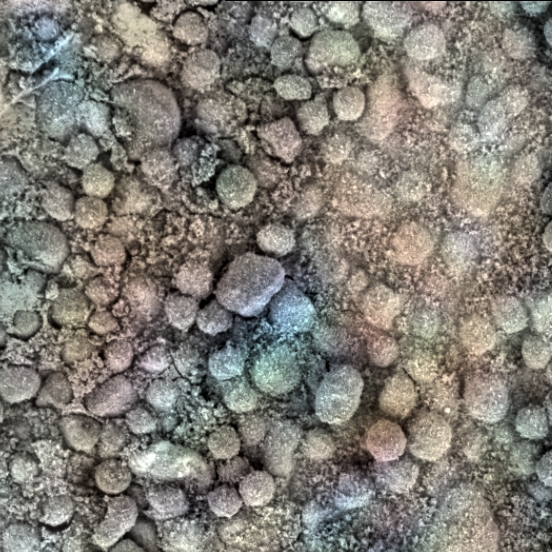
But they used infrared filters for this image, so it's not the real colours.
By the way, this is the area where the close-up image comes from: marsrover.nasa.gov... your "plant" is somewhere there.
Here's my RGB composite of the Pancam image, which should show the real colours:
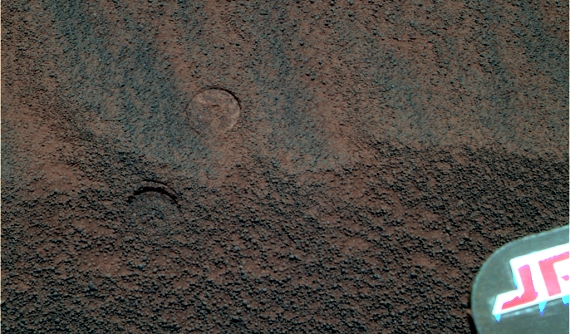
edit on 8-8-2013 by wildespace because: (no reason given)
There are a couple more 'Y'-shaped structures at the top left of the image as well. These could be more tops (first 2 leaves) of the plant if it is
indeed some kind of plant.
Are we specifically looking for more images of the same place or are we looking for more of these structures?
As far as I know there is no colour information from the MI, but I think I remember that they stack multiple images to get a larger depth of the image in focus.
Are we specifically looking for more images of the same place or are we looking for more of these structures?
As far as I know there is no colour information from the MI, but I think I remember that they stack multiple images to get a larger depth of the image in focus.
Here is a root-like structure which appears to go along and then over the side of a blueberry. In the background there is also another root-looking
structure. All arrowed but the original is here
OK, I realise these structures are very small, but I do not think they are mineral deposits, do you?
something like a fillament or string structure
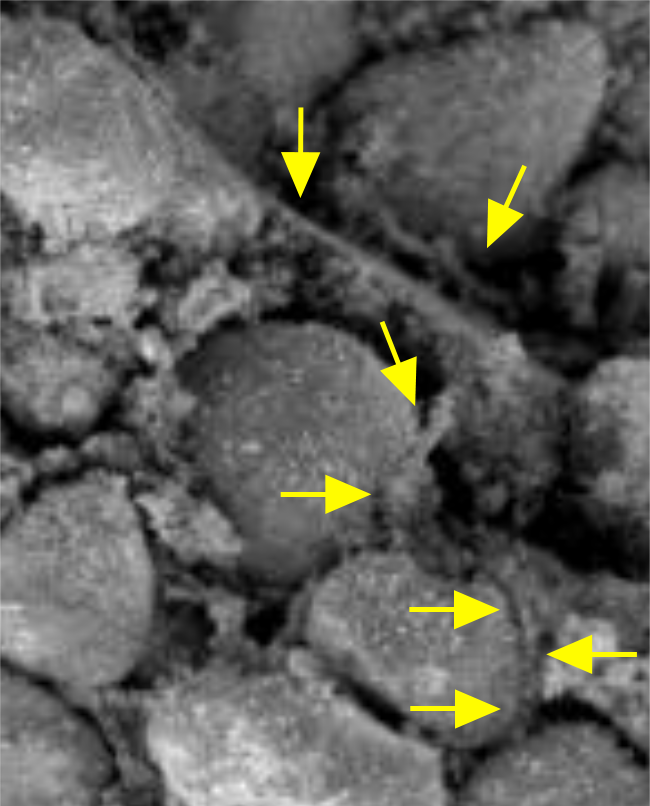
Here is another one upper left quadrant near the edge original link
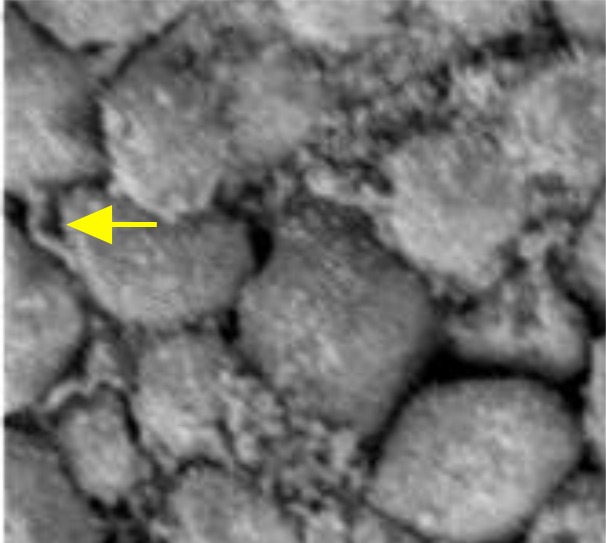
OK, I realise these structures are very small, but I do not think they are mineral deposits, do you?
something like a fillament or string structure

Here is another one upper left quadrant near the edge original link

edit on 8 Aug 2013 by qmantoo because: another
I thought I would post some more URLs to images of this structure. If anyone can make a stacked image that would probably be as good as we can get.
Maybe an anaplyph would be useful too perhaps.
marsrovers.jpl.nasa.gov...
marsrovers.jpl.nasa.gov...
marsrovers.jpl.nasa.gov...
marsrovers.jpl.nasa.gov...
marsrovers.jpl.nasa.gov...
marsrovers.jpl.nasa.gov...
marsrovers.jpl.nasa.gov...
marsrovers.jpl.nasa.gov...
Also another view pointing out branches(yellow markers) and moss/lichen very simple leaf-looking structure(blue marker)
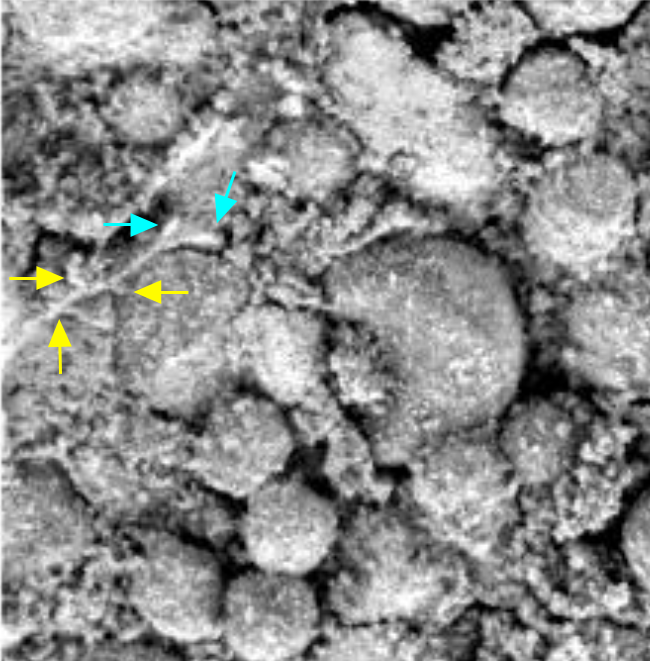
marsrovers.jpl.nasa.gov...
marsrovers.jpl.nasa.gov...
marsrovers.jpl.nasa.gov...
marsrovers.jpl.nasa.gov...
marsrovers.jpl.nasa.gov...
marsrovers.jpl.nasa.gov...
marsrovers.jpl.nasa.gov...
marsrovers.jpl.nasa.gov...
Also another view pointing out branches(yellow markers) and moss/lichen very simple leaf-looking structure(blue marker)

OK, two more examples of this leaf-like structure. Both found
in the same MI images here
The first is on some kind of what I call a 'mushroom-like' structure more towards the centre right of the image.
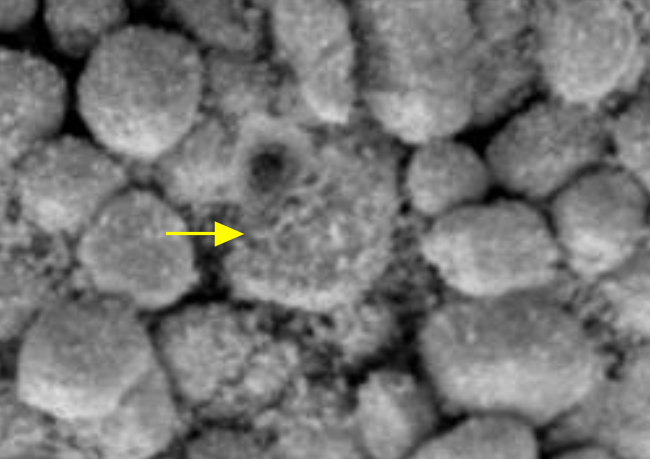
The second just shows what a sad nerdy person I am, because this is absolutely minute - yet you can still see it has the characteristic 'Y' set of leaf-liks structures. If they are mineralistic, then they are everywhere in this Site 52 area. This one is bottom left corner area.

The first is on some kind of what I call a 'mushroom-like' structure more towards the centre right of the image.

The second just shows what a sad nerdy person I am, because this is absolutely minute - yet you can still see it has the characteristic 'Y' set of leaf-liks structures. If they are mineralistic, then they are everywhere in this Site 52 area. This one is bottom left corner area.

reply to post by wildespace
that bottom image you posted ? is that taken on mars as they look like 2 pennies
that bottom image you posted ? is that taken on mars as they look like 2 pennies
reply to post by geobro
They are both where the rover's RAT or Rock Abrasion Tool has been used on the rock to grind or clean a small amount off the surface so that it can be examined & photographed.
They are both where the rover's RAT or Rock Abrasion Tool has been used on the rock to grind or clean a small amount off the surface so that it can be examined & photographed.
My guess would be that it's martian dust/soil, compacted into lines by the surrounding blueberries. Or they might be vein-like concretions, like in
this image: 2.bp.blogspot.com... from
washingtonlandscape.blogspot.co.uk...
Although I cannot see anything with 'blogspot' in the URL(due to my location), I also cannot see how something the average size of 5mm can compact anything and I rate this guess of yours as a bit of a stretch of the imagination. If I had made such a way out guess you would be straight onto it and have been in the past.
My guess would be that it's martian dust/soil, compacted into lines by the surrounding blueberries. Or they might be vein-like concretions,
What is it about these images of different "things" which are not doing it for you? What is a vein-like concretion? I am assuming it is a mineral vein which has been 'weathered' out of the surrounding rock and appears in vegetable matter looking shapes and sizes. Sounds like gobbledegook to me. Is a vein-like concretion like a "plant-like structure" or a "leaf-like shape", or an "ancient-looking vegetable collection of cells"? I think you are going to have do to better than that to explain away these oddities which are popping up in MI images.
Maybe in your house a kettle is a "shiny weathered mineral vessel possibly once containing some kind of liquid". :-)
edit on 9 Aug 2013 by
qmantoo because: typo
reply to post by qmantoo
I'll post the image here:
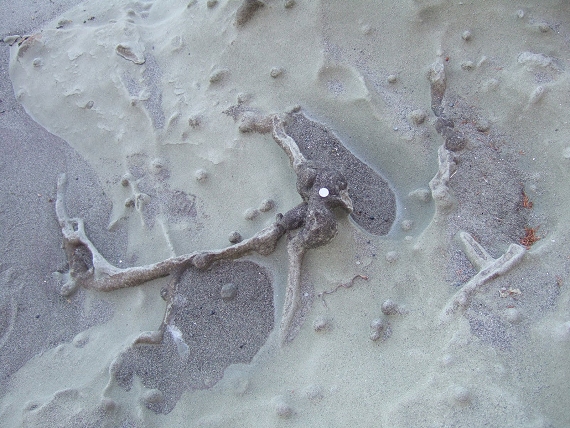
I hope you will agree that this looks plant-like or fossil-like.
I agree that the objects you point out in mars images are very interesting and look unusual, and I would love to know exactly what it is. But then many geological processes on Earth produce very interesting and unusual formations, some of which can look like plant or animal fossils.
I'll post the image here:

I hope you will agree that this looks plant-like or fossil-like.
I agree that the objects you point out in mars images are very interesting and look unusual, and I would love to know exactly what it is. But then many geological processes on Earth produce very interesting and unusual formations, some of which can look like plant or animal fossils.
reply to post by qmantoo
Could be might not be but what I can say is there is no real point in zooming in so far that image has jpeg artifacts all over it although you saved it as a png the original was a jpeg.

If you look at the area below the top arrow point you will see lines that look like steps ie straight edges.
Could be might not be but what I can say is there is no real point in zooming in so far that image has jpeg artifacts all over it although you saved it as a png the original was a jpeg.

If you look at the area below the top arrow point you will see lines that look like steps ie straight edges.
I hope you will agree that this looks plant-like or fossil-like.
I do agree, but you fail to appreciate that I have found at least 3 separate instances which have similar characteristics. You have given us one. It is the similar characteristics which make it more unusual and the similar looking features make it more likely that these are found throughout this Site. I am sure you will appreciate that too.
Yes what you say is correct I did save it as a png. There are compression artifacts in all jpg photos why are you pointing out compression artifacts when the arrows point to other structures which are in the original - which is also a jpg. Thats why I gave a link to the original for you to look for yourself and not take my word for it. If you think you can find a better image whoch shows what these really are and which gives weight to your beliefs, then please go ahead. This is a discussion thread not a "lets criticise the methods used by the OP" thread.
Could be might not be but what I can say is there is no real point in zooming in so far that image has jpeg artifacts all over it although you saved it as a png the original was a jpeg.
If you look at the area below the top arrow point you will see lines that look like steps ie straight edges.
If I only found one instance, then we can argue till the cows come home, but for 3 similar features to be in the same area, that maybe more meaningful and significant in anyone's science. Do not belittle this series of postings just because it does not fit in with your beliefs.
new topics
-
The good, the Bad and the Ugly!
Diseases and Pandemics: 1 hours ago -
Russian intelligence officer: explosions at defense factories in the USA and Wales may be sabotage
Weaponry: 3 hours ago -
African "Newcomers" Tell NYC They Don't Like the Free Food or Shelter They've Been Given
Social Issues and Civil Unrest: 4 hours ago -
Russia Flooding
Other Current Events: 6 hours ago -
MULTIPLE SKYMASTER MESSAGES GOING OUT
World War Three: 6 hours ago -
Two Serious Crimes Committed by President JOE BIDEN that are Easy to Impeach Him For.
US Political Madness: 7 hours ago -
911 emergency lines are DOWN across multiple states
Breaking Alternative News: 7 hours ago -
Former NYT Reporter Attacks Scientists For Misleading Him Over COVID Lab-Leak Theory
Education and Media: 9 hours ago -
Why did Phizer team with nanobot maker
Medical Issues & Conspiracies: 9 hours ago -
Pro Hamas protesters at Columbia claim hit with chemical spray
World War Three: 10 hours ago
top topics
-
Go Woke, Go Broke--Forbes Confirms Disney Has Lost Money On Star Wars
Movies: 14 hours ago, 13 flags -
Pro Hamas protesters at Columbia claim hit with chemical spray
World War Three: 10 hours ago, 11 flags -
Elites disapearing
Political Conspiracies: 12 hours ago, 9 flags -
Freddie Mercury
Paranormal Studies: 14 hours ago, 7 flags -
African "Newcomers" Tell NYC They Don't Like the Free Food or Shelter They've Been Given
Social Issues and Civil Unrest: 4 hours ago, 7 flags -
A Personal Cigar UFO/UAP Video footage I have held onto and will release it here and now.
Aliens and UFOs: 12 hours ago, 5 flags -
Two Serious Crimes Committed by President JOE BIDEN that are Easy to Impeach Him For.
US Political Madness: 7 hours ago, 5 flags -
Russian intelligence officer: explosions at defense factories in the USA and Wales may be sabotage
Weaponry: 3 hours ago, 4 flags -
911 emergency lines are DOWN across multiple states
Breaking Alternative News: 7 hours ago, 4 flags -
Former NYT Reporter Attacks Scientists For Misleading Him Over COVID Lab-Leak Theory
Education and Media: 9 hours ago, 4 flags
active topics
-
Russian intelligence officer: explosions at defense factories in the USA and Wales may be sabotage
Weaponry • 59 • : theatreboy -
African "Newcomers" Tell NYC They Don't Like the Free Food or Shelter They've Been Given
Social Issues and Civil Unrest • 8 • : FlyersFan -
Elites disapearing
Political Conspiracies • 22 • : CitizenB -
I Guess Cloud Seeding Works
Fragile Earth • 22 • : Degradation33 -
Russia Flooding
Other Current Events • 3 • : theatreboy -
-@TH3WH17ERABB17- -Q- ---TIME TO SHOW THE WORLD--- -Part- --44--
Dissecting Disinformation • 520 • : cherokeetroy -
Former NYT Reporter Attacks Scientists For Misleading Him Over COVID Lab-Leak Theory
Education and Media • 3 • : Hakaiju -
Two Serious Crimes Committed by President JOE BIDEN that are Easy to Impeach Him For.
US Political Madness • 9 • : Myhandle -
MULTIPLE SKYMASTER MESSAGES GOING OUT
World War Three • 15 • : cherokeetroy -
A Personal Cigar UFO/UAP Video footage I have held onto and will release it here and now.
Aliens and UFOs • 10 • : Hakaiju
